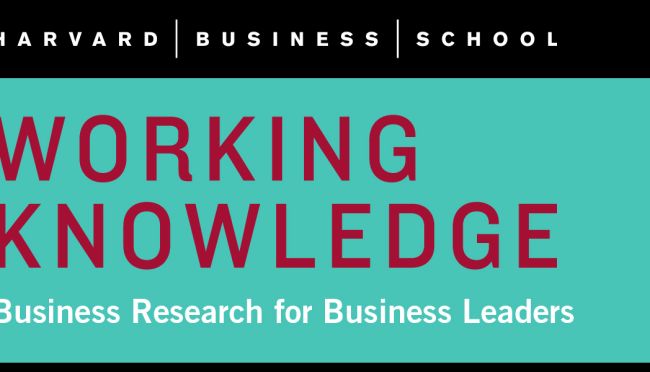Framework →
→
- 22 Mar 2010
- Research & Ideas
One Strategy: Aligning Planning and Execution
Strategy as it is written up in the corporate playbook often becomes lost or muddled when the team takes the field to execute. In their new book, Professor Marco Iansiti and Microsoft's Steven Sinofsky discuss a "One Strategy" approach to aligning plan and action. Key concepts include: The book combines practical experience at Microsoft with conceptual frameworks on how to develop strategies that are aligned with execution in a rapidly changing competitive environment. "Strategic integrity" occurs when the strategy executes with the full, aligned backing of the organization for maximum impact. The chief impediment to strategy execution is inertia. The One Strategy approach is less about formal reviews and more about one-on-one conversation. Blogs can be a powerful asset in managing an organization. Closed for comment; 0 Comments.

- 24 Nov 2009
- Working Paper Summaries
From Strategy to Business Models and to Tactics
Drivers such as globalization, deregulation, or technological change, just to mention a few, are profoundly changing the competitive game. Scholars and practitioners agree that the fastest-growing firms in this new environment appear to have taken advantage of these structural changes to compete "differently" and innovate in their business models. However, there is not yet agreement on what are the distinctive features of superior business models. This dispute may have arisen, in part, because of a lack of a clear distinction between the notions of strategy, business model, and tactics. HBS professor Ramon Casadesus-Masanell and Joan Enric Ricart present an integrative framework to distinguish and relate the concepts of business model, strategy, and tactics. Key concepts include: An integrative framework that cleanly separates the realm of business model, strategy, and tactics will help guide the search for novel, interesting, and profitable new ways to compete. "Business model" refers to the logic of the firm, the way it operates, and how it creates value for its stakeholders. "Strategy" refers to the choice of business model through which the firm will compete in the marketplace. "Tactics" refers to the residual choices open to a firm by virtue of the business model that it employs. Closed for comment; 0 Comments.
- 18 Jul 2005
- Research & Ideas
Identify Emerging Market Opportunities
Yes, you understand your company needs to compete in emerging markets. But which country is the best fit for you? A Harvard Business Review excerpt by Tarun Khanna, Krishna G. Palepu, and Jayant Sinha. Closed for comment; 0 Comments.
- 02 Feb 2004
- Research & Ideas
Mapping Your Corporate Strategy
From the originators of the Balanced Scorecard system, Strategy Maps is a new book that explores how companies can best their competition. A Q&A with Robert S. Kaplan. Closed for comment; 0 Comments.
- 30 Sep 2002
- Research & Ideas
Your Crisis Response Plan: The Ten Effective Elements
Shooter on site. Epidemic. Major power outage. Is your organization prepared to deal with crisis? HBS professor Michael Watkins explains what you need to know, and offers a checklist to evaluate your preparedness. Closed for comment; 0 Comments.
- 29 Jul 2002
- Research & Ideas
Time Pressure and Creativity: Why Time is Not on Your Side
Even as time pressures increase in corporate life, the need for creative thinking has never been greater, says Harvard Business School professor Teresa Amabile. Closed for comment; 0 Comments.

Why Every Company Needs a CSR Strategy and How to Build It
Despite certain criticisms, more and more companies in the world practice some form of corporate social responsibility. This paper offers a pragmatic alternative framework for CSR with a view towards developing its practice in an evolutionary way. The authors' extensive experience working with CSR practitioners convinces them that exhorting companies to hone their CSR practice under a shared value framework does not reflect the reality for a majority of businesses. CSR executives oversee a variety of social initiatives that may or may not directly contribute to a company's business goals. The role of an executive is to achieve the difficult task of reconciling the various programs, quantifying their benefits, or at least sketching a logical connection to the business, and securing the support of his or her business line counterparts. This role, when performed well, would lead to the development of a CSR strategy for the company. Key concepts include: Ideally, well-managed CSR creates social and environmental value, while supporting a company's business objectives and reducing operating costs, and enhancing relationships with key stakeholders and customers. There is no one-size-fits-all CSR model. Individual companies typically engage in a variety of programs motivated by a wide range of perspectives and corporate protagonists. In current practice, the management of philanthropic initiatives happens in what the authors label as Theatre 1; supply chain and cause marketing initiatives happen in Theatre 2; and transformative ecosystem initiatives occur in Theatre 3. These different initiatives are typically managed at different management levels, and some are staff functions and others line functions, resulting in a messy state of affairs. Gaining a unified vision is a central challenge of coordinating CSR efforts in all three theatres. In addition to empowering CSR executives to practice strategic initiatives, strong leadership and support for CSR initiatives at the top levels of executive management is critical. The strategic role of a Corporate Responsibility Officer needs to be established as an independent full-time position having access to the CEO and having input to the development of the company's business strategy. Closed for comment; 0 Comments.